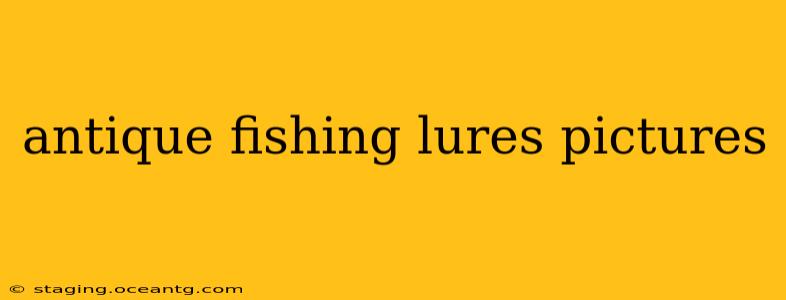Antique fishing lures represent more than just fishing equipment; they're captivating glimpses into angling history, reflecting evolving designs, materials, and fishing techniques. From the hand-painted artistry of early lures to the innovative engineering of later models, these collectible items offer a fascinating window into the past. This article explores the world of antique fishing lures, delving into their history, identification, and the joy of collecting them.
What Makes a Fishing Lure "Antique"?
Determining what constitutes an "antique" fishing lure is subjective, but generally, lures manufactured before the mid-20th century (roughly pre-1950s) are considered antique. However, the rarity, condition, and historical significance of a lure also play a significant role. Some lures from the later part of the 20th century can also be considered valuable collector's items, especially those with limited production runs or unique features. The age alone doesn't define value; factors like maker, design, condition, and overall rarity heavily influence an antique lure's worth.
Identifying Antique Fishing Lures: Key Features and Makers
Identifying antique fishing lures requires keen observation. Look for clues like:
- Materials: Early lures often used materials like wood, bone, celluloid, and hand-painted finishes. Later lures incorporated metal, plastic, and more sophisticated paint jobs. The materials used can significantly date a lure.
- Construction: Hand-crafted lures often display imperfections and unique characteristics that mass-produced lures lack. Examine the details; inconsistencies can indicate age and craftsmanship.
- Paint and Finishes: The style of paint application, colors used, and level of detail can be crucial identifiers. Faded or chipped paint can often indicate age but also affects value.
- Hardware: The type of hooks, swivels, and other metal components can provide clues about the manufacturing period. Examine these for wear, corrosion, and style.
- Maker's Marks: Many antique lures bear markings or stamps indicating the manufacturer. Researching these markings is key to identifying the lure's maker and approximate age. Identifying the maker is a crucial step in determining its value and historical context. Some highly sought-after names include Creek Chub, Heddon, South Bend, and Shakespeare.
Where to Find Pictures of Antique Fishing Lures?
Finding pictures of antique fishing lures is easier than ever thanks to the internet. Excellent resources include:
- Online Auction Sites: Sites like eBay and others showcase a wide array of antique fishing lures with accompanying photos. These sites provide a vast visual database for research and identification.
- Specialized Collector Websites and Forums: Numerous websites and online forums dedicated to antique lure collecting offer extensive image galleries and detailed discussions on specific lures. These communities are invaluable for identifying rare or obscure models.
- Books and Magazines: Several books and magazines specialize in antique fishing lures and their history. These often contain high-quality photographs and valuable information for both beginners and seasoned collectors.
- Museums and Archives: Some museums and archives related to fishing or Americana may have online collections featuring antique lures with detailed descriptions and high-resolution images.
Are Antique Fishing Lures Worth Anything?
The value of an antique fishing lure can vary dramatically depending on many factors, as previously mentioned. Rarity, condition, maker, and overall desirability in the collector's market all play a role. Some extremely rare lures can fetch thousands of dollars, while others may be worth only a few dollars. Condition is extremely important; a lure in pristine condition will command a significantly higher price than a damaged or heavily used one. The best way to determine the value of a specific lure is to consult with experienced collectors or appraisers specializing in antique fishing lures.
How Can I Tell if My Fishing Lure is Antique?
To determine if your fishing lure is antique, carefully examine its features, considering the material, construction, paint, hardware, and any maker's marks. Compare your findings to pictures and information found in the resources mentioned above. If you're unsure, seeking guidance from experienced collectors or appraisers specializing in antique fishing lures is always recommended. Thorough research and comparison are key to accurate identification.
What are the Most Valuable Antique Fishing Lures?
Pinpointing the most valuable antique fishing lures is difficult due to the constantly fluctuating collector market. However, certain lures consistently command high prices due to rarity, historical significance, and desirability. Lures from well-known manufacturers like Heddon, with unusual or limited-edition designs, are often highly sought after. The value is significantly influenced by the lure's condition and any original packaging. Specific models and variations within a manufacturer's line can also impact the value dramatically.
This exploration of antique fishing lures provides a starting point for those interested in this fascinating hobby. Remember, the beauty of collecting lies not only in the monetary value but also in the stories these lures tell about angling history and the enduring appeal of the sport.
